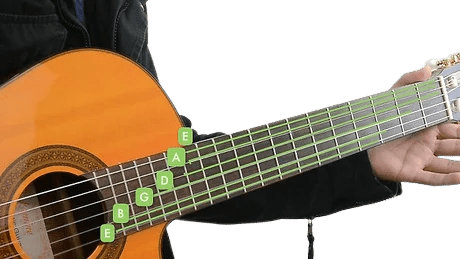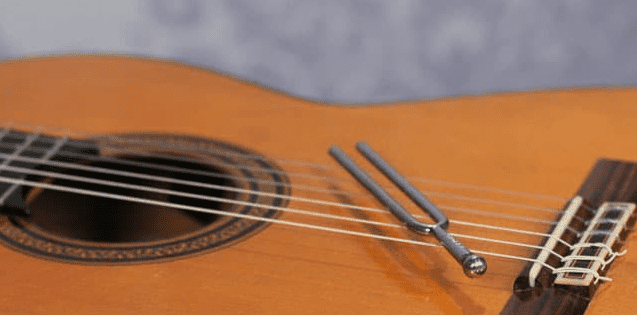Neither you want to play the guitar that is out of tune, nor does anyone want to listen to it. Tuning this stringed instrument with guitar tuners is an effortless task, but what to do when you don’t have any tuner? The good news is that you can tune a guitar with a tuner. However, it is essential to tune an acoustic guitar using tuners made for it, as without tuners, it is difficult to tuner your instrument to absolute pitch.
How to Tune a Guitar Without a Tuner – 2 Effective Tuning Techniques
Technique #1: Tuning the Guitar to itself
First of all, you need to fret the low E string ah the 5th fret. The low E string (6th string) is the thickest and lowest string on the Guitar. If you are holding Guitar in a playing position while looking down at it, the top strings will be closest to you.
The note at the 5th fret of the low E is similar to the open A string.
For this technique, it is not essential to first tune the low E string. Even though the Guitar may not be absolute pitch or concert pitch, the string will be decently tuned to each other.
Anything you want to play will sound right as far as you are playing it by yourself and not with the instrument to the concert pitch.
Match the open “A” string to its “low E” string at the 5th fret. Carefully listen to the sound from the low E string and then play the open A string.
Now tune the open A string down or up until it matches the tune coming from the low E string.
In the case of the open, A string is higher than A; you play at the 5th fret of the low E string; it is better to tune the guitar down and then bring it back up.
Repeat this process to tune the G and D strings. Once the A is in tune, fret it at the 5th fret and pluck it.
Now pluck the open D string and then tune it down or up to match.
When a D string is in tune, make sure to fret it at the 5th fret to play a G.
To compare it, pluck the open G string and tune it down or up to match the tune.
Fret the G at the 5th fret to tune the B string. The procedure may change for the B string as there is a short interval between B and G.
Fret the G string at the 4th fret to play a B. Also, pluck the open B string and then compare the tones.
Tune the open B string down or up until it matches the tone produced on the G string.
Return to the 5th fret to tune the high E string. When you have the B string in tune, fret it at the 5th fret and pluck to play a high E.
Tune the open high E string down or up to match the tone coming from the B string.
It’s time to strum few chords to check the tuning. If you are going to play a song, you need to check the tuning with chords from the particular song to ensure the sound is pleasing.
Listen carefully and adjust down or up according to the needs.
You can make use of a tune-checking chord to check whether the Guitar is appropriately tuned or not.
Technique #2: Tuning Guitar using Harmonics
Touch the strings decently to play harmonics. You can play natural harmonics at the 12th, 7th, and 5th frets. Touch the strings above the fret and don’t apply any pressure. Strike the note while releasing the string at the fret at the same time you pluck it.
If you don’t have any experience with harmonics, you need to do some practice before getting used to it.
Once you listen to the bell-like sound, you have done the perfect job.
Harmonic is a quiet technique to tune a guitar without a tuner. If there the environment around you is noisy, you cannot use the method correctly.
To check the Guitar’s intonation, play the harmonics at the 12th fret. If your acoustic guitar intonation is off, these harmonics won’t match the pitch of the similar not when you fret the note and play it.
Select the string and play the harmonic at the 12th fret and then fret the 12th note to play the original note.
Repeat the process with each string as the intonation may not be perfect on few strings but off on other ones.
If the intonation is off, change strings and check if it fixes the issue. If it doesn’t, you have to take the Guitar to the nearby shop to check for the technical issues.
Compare the harmonics to tune the A string to the low E. Play harmonics on the 5th fret at the low E string and play the harmonic on the 7th fret of the A string. Carefully listen to the tone. If needed, play them few times.
Tune the A string down or up until the harmonics perfectly match the pitch of the harmonic you have played on the low E string.
If you haven’t tuned the low E string to a reference note, the Guitar will be tuned to itself, not correctly tuned to the absolute pitch or concert pitch.
Repeat the procedure with the G and D strings. When the A string is in tune, play the harmonic on the 55th fret of the A string and then compare it to the harmonic on the 7th fret of the D string.
Now tune the D string down or up as needed to match the pitch.
Play harmonics on the 5th fret of the D to tune the G string and compare it to the harmonic on the 7th fret of the G string.
Play the harmonic on the 7th fret of the low E string for tuning the B string. The harmonic on the 7th fret of the low E string will produce the same pitch as the open B. It is not essential to play harmonics on the B string. All you need is to strum the open string.
If needed, tune the B string down and up to match the pitch perfectly.
Now tune the high E string with harmonic on the 7th fret of the A string. The technique for tuning the high E string is just like the process you have used for the B string.
The open-high E string must match the pitch produced when playing the harmonic on the 7th fret of the A string.
Once you have tuned to the high E string, the guitar should be in tune ideally. Play some chords to ensure everything sounds perfect.
Useful Tips
- The Guitar will stay in tune for a long time If you change the acoustic guitar strings regularly.
- Don’t expose your Guitar to significant humidity or temperature fluctuations.
- Tune the strings down first if they sound higher than they should. Then tune the string up to the correct pitch.
- When you tune the strings, it helps to lock the tension in a string so that it won’t slip.
- You need to use a tuning app if you don’t have a proper hearing sense. You can easily find different smartphones apps for free to tune your Guitar.


